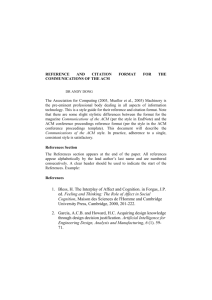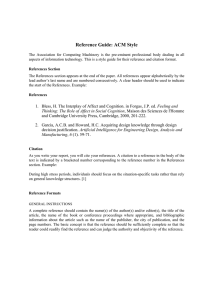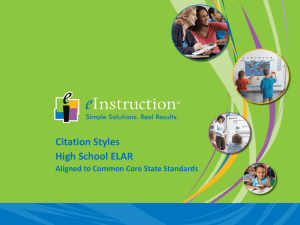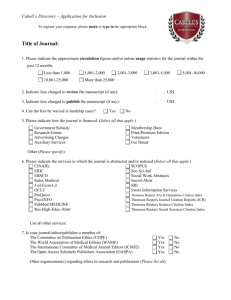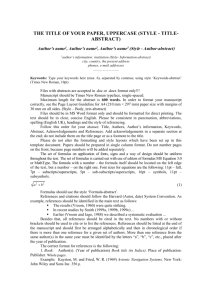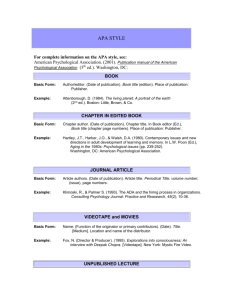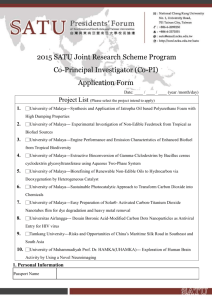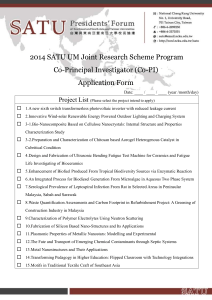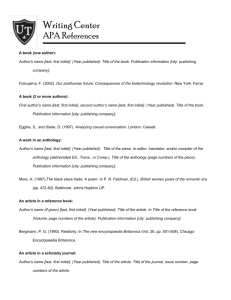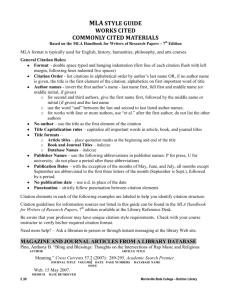ACM Reference Format
advertisement
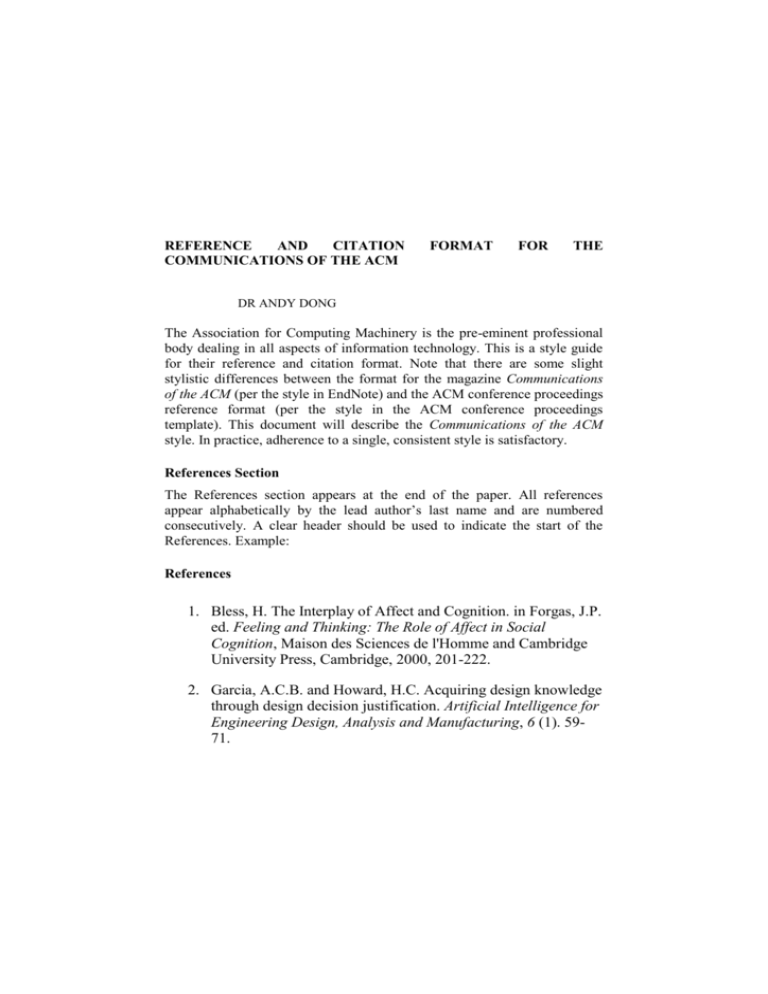
REFERENCE AND CITATION COMMUNICATIONS OF THE ACM FORMAT FOR THE DR ANDY DONG The Association for Computing Machinery is the pre-eminent professional body dealing in all aspects of information technology. This is a style guide for their reference and citation format. Note that there are some slight stylistic differences between the format for the magazine Communications of the ACM (per the style in EndNote) and the ACM conference proceedings reference format (per the style in the ACM conference proceedings template). This document will describe the Communications of the ACM style. In practice, adherence to a single, consistent style is satisfactory. References Section The References section appears at the end of the paper. All references appear alphabetically by the lead author’s last name and are numbered consecutively. A clear header should be used to indicate the start of the References. Example: References 1. Bless, H. The Interplay of Affect and Cognition. in Forgas, J.P. ed. Feeling and Thinking: The Role of Affect in Social Cognition, Maison des Sciences de l'Homme and Cambridge University Press, Cambridge, 2000, 201-222. 2. Garcia, A.C.B. and Howard, H.C. Acquiring design knowledge through design decision justification. Artificial Intelligence for Engineering Design, Analysis and Manufacturing, 6 (1). 5971. 2 A. AUTHOR, B. AUTHOR AND C. AUTHOR Citation As you write your report, you will cite your references. A citation to a reference in the body of the text is indicated by a bracketed number corresponding to the reference number in the References section. Example: During high stress periods, individuals should focus on the situation-specific tasks rather than rely on general knowledge structures. [1] Reference Formats GENERAL INSTRUCTIONS A complete reference should contain the name(s) of the author(s) and/or editor(s), the title of the article, the name of the book or conference proceedings where appropriate, and bibliographic information about the article such as the name of the publisher, the city of publication, and the page numbers. The basic concept is that the reference should be sufficiently complete so that the reader could readily find the reference and can judge the authority and objectivity of the reference. All author names appear as Lastname, Initials. For example, if Andy Dong is the primary author and Alice M. Agogino is the second author, the correct appearance of the author names would be: Dong, A., and Agogino, A.M. THIS IS THE REFERENCE FORMAT FOR A BOOK. Authors. Title. Publisher, City of Publication, Year of Publication. Example: 1. Fogg, B.J. Persuasive technology: using computers to change what we think and do. Morgan Kaufmann Publishers, Boston, 2003. THIS IS THE REFERENCE STYLE FOR AN ARTICLE WHICH APPEARS IN AN EDITED BOOK. Authors. Title. in Editors Title of edited book, Publisher, City of Publication, Year of Publication, Pages. Example: 1. Fischer, G. and Nakakoji, K. Amplifying designers’ creativity with domain-oriented design environments. in Dartnall, T. ed. Artificial Intelligence and Creativity: An Interdisciplinary Approach, Kluwer Academic Publishers, Dordrecht, 1994, 343-364. THIS IS THE REFERENCE STYLE FOR A JOURNAL OR MAGAZINE ARTICLE. Authors. Title. Journal or magazine name, Volume (Issue), Pages. Example: 1. Hirsh, H., Coen, M.H., Mozer, M.C., Hasha, R. and Flanagan, J.L. Room service, AI-style. IEEE intelligent systems, 14 (2). 8-19. THIS IS THE REFERENCE STYLE FOR A CONFERENCE PROCEEDINGS. Authors, Title. in Title of conference, (Location of Conference, Year), Publisher, Pages. Example: 1. Leclercq, P. and Heylighen, A. 5,8 Analogies per hour: A designer's view on analogical reasoning. in 7th International Conference on Artificial Intelligence in Design, (Cambridge, UK, 2002), Kluwer Academic Publishers, 285-303. THIS IS THE REFERENCE STYLE FOR ELECTRONIC MEDIA (ARTICLES, IMAGES, ETC.) RETRIEVED FROM THE WEB. FOLLOW THE REFERENCE FORMAT FOR A JOURNAL ARTICLE AND THEN INCLUDE INFORMATION ABOUT THE WEB SITE AND THE DATE WHEN YOU RETRIEVED THE RESOURCE. NOTE THAT THE DATE OF PUBLICATION AND THE DATE OF RETRIEVAL OF THE ARTICLE MAY NOT BE THE SAME. WHEN THERE IS NO DETERMINATE DATE OF PUBLICATION, USE (N.D.) IN THE DATE FIELD. WHERE POSSIBLE, INCLUDE THE NAME OF THE ORGANIZATION HOSTING THE WEB SITE. Examples: 4 A. AUTHOR, B. AUTHOR AND C. AUTHOR In the following example, the Cornell Chronicle is a regular newsletter which is published online. Thus, we follow the journal/magazine format and include the volume and issue. Steele, B. Look, Ma, no wires! Cornell class project tests wireless networking, Cornell Chronicle, 31 (35). Retrieved February 15, 2004, from Columbia University: http://www.news.cornell.edu/Chronicle/00/5.18.00/wireless_class.html. The following Web page has no evident author, but the “Revised date” in the footer gives us the date of publication. MIT Project Oxygen: Overview, 2004. Retrieved March 15, 2005, from Computer Science and Artificial Intelligence Laboratory, Massachusetts Institute of Technology: http://oxygen.lcs.mit.edu/Overview.html.
